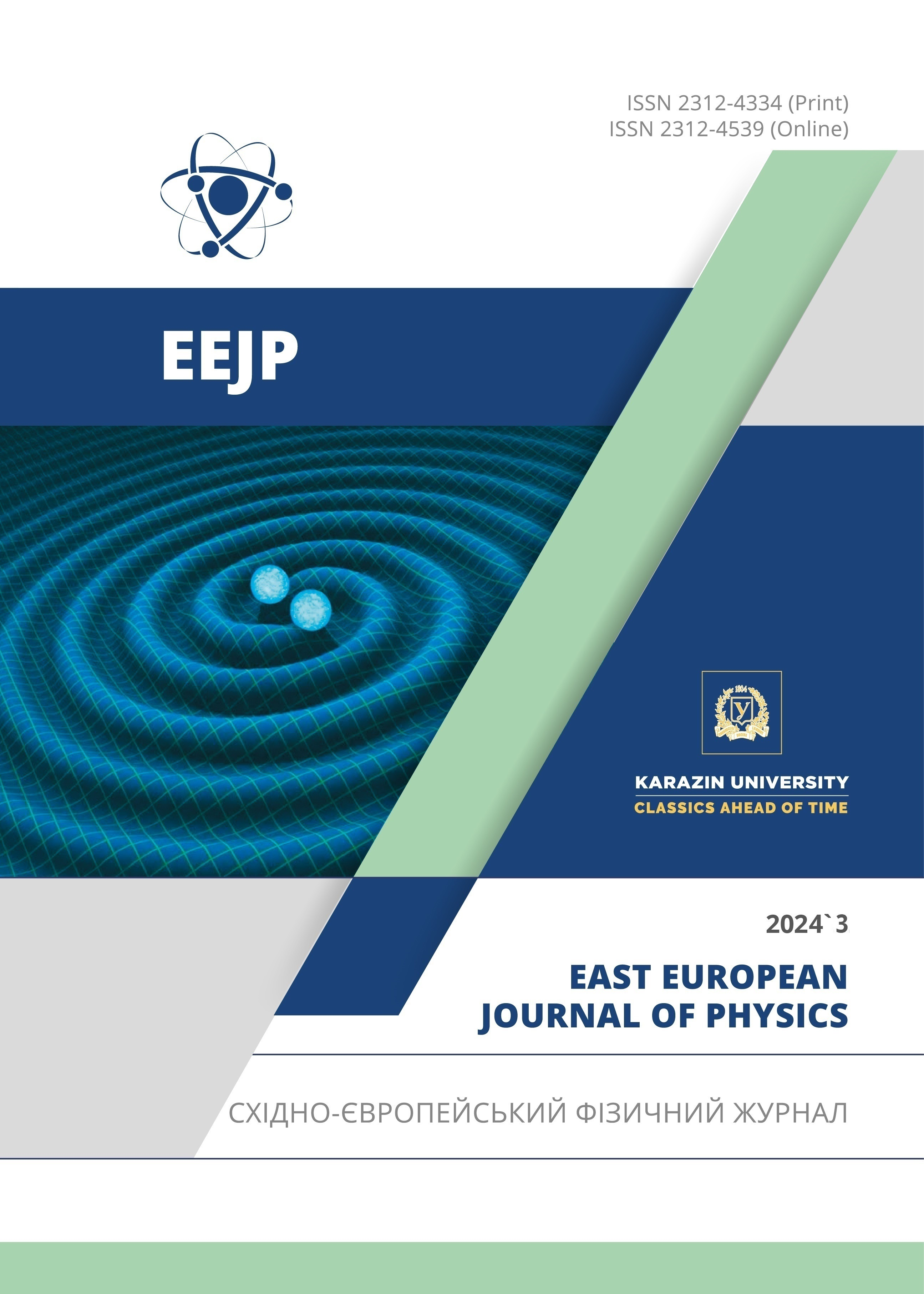Structural Properties of Al-Doped ZnO Films
Abstract
In this study, the results of the investigation of the influence of Al atoms on the structural characteristics of ZnO films obtained by the sol-gel method are presented. It has been determined that the glass substrates consist of subcrystallites with dimensions of 28.6 nm, having cubic unit cells with lattice parameters a = 0.3336 nm, and their surfaces belong to the crystallographic orientation (111). It has been identified that the grown thin ZnO films consist of subcrystallites with dimensions of 39.5 nm, having a wurtzite structure with lattice parameters a = b = 0.3265 nm and c = 0.5212 nm, respectively. It has been determined that at the boundaries of the division of these subcrystallites, polycrystalline regions with sizes of 12.6 nm, 28.3 nm, 30 nm, and 33 nm are formed. Additionally, nanocrystallites with sizes of 56.8 nm self-assemble on the surface areas of the deposited films. The increase in the values of the “c”axis of the hexagonal crystal lattice of ZnO films by 0.0009 nm when doping Al atoms from 1% to 5% is explained by the shift of the main structural line (002) at small angles (Δθ=0.12°). It has been established that nanocrystallites with lattice parameters аn = 0.5791 nm, belonging to the spatial group Fd3m, self-assemble on the surface areas of ZnO:Al films. the curve due to the presence of a monoenergetic level of fast surface states at the heterojunction.
Downloads
References
S. Zainabidinov, S.I. Rembeza, E.S. Rembeza, Sh.Kh. Yulchiev,” Applied Solar Energy,” Academic Journal, 55(1), 5 (2019). https://doi.org/10.3103/S0003701X19010146
Kh. J. Mansurov, A.Y. Boboyev, and J.A. Urinboyev, “X-ray structural and photoelectric properties of SnO2, ZnO, and Zn2SnO4 metal oxide films,” East European Journal of Physics. (2), 336-340 (2024). https://doi.org/10.26565/2312-4334-2024-2-39
M. Laurenti, S. Stassi, M. Lorenzoni, M. Fontana, G. Canavese, V. Cauda, and C.F. Pirri, “Evaluation of the piezoelectric properties and voltage generation of flexible zinc oxide thin films,” Nanotechnology, 26(21), 1 (2019) https://doi.org/10.1088/0957-4484/26/21/215704
K. Chongsri, and W. Pecharapa, “UV Photodetector Based On Al-Doped Zno Nanocrystalline Sol-Gel Derived Thin Fims” Energy Procedia, 56, 554–559 (2014). https://doi.org/10.1016/j.egypro.2014.07.192
P. Koralli, S.F. Varol, G. Mousdis, D.E. Mouzakis, Z. Merdan, M. Kompitsas, “Chemosensors. Comparative Studies of Un-doped/Al-Doped/In-Doped ZnO Transparent Conducting Oxide Thin Films in Optoelectronic Applications,” Chemosensors, 10(5), 162 (2022). https://doi.org/10.3390/ chemosensors10050162
F.I. Alresheedi, and J.E. Krzanowski, “X-ray Diffraction Investigation of Stainless Steel—Nitrogen Thin Films Deposited Using Reactive Sputter Deposition,” Coatings, 10, 984 (2020). https://doi.org/10.3390/coatings10100984
S.Z. Zaynabidinov, A.Y. Boboev, and N.Y. Yunusaliyev, “Effect of γ-irradiation on structure and electrophysical properties of S-doped Zno films,” East European Journal of Physics, (2), 321-326 (2024). https://doi.org/10.26565/2312-4334-2024-2-37.
S. Zaynabidinov, Sh. Yuldashev, A. Boboev, and N. Yunusaliyev, “X-ray diffraction and electron microscopic studies of the ZnO(S) metal oxide films obtained by the ultrasonic spray pyrolysis method,” Herald of the Bauman Moscow State Technical University, Series Natural Sciences, 1(112), 78-92 (2024). https://doi.org/10.18698/1812-3368-2024-1-78-92
S.Z. Zainabidinov, Sh.B. Utamuradova, and A.Y. Boboev, “Structural Peculiarities of the (ZnSe)1–x–y(Ge2)x(GaAs1–δBiδ)y Solid Solution with Various Nanoinclusions,” Journal of Surface Investigation, Synchrotron and neutron techniques, 48-52 (2024). https://doi.org/10.18698/1812-3368-2024-1-78-92
V. Utyaganova, et. al., “Controlling the porosity using exponential decay heat input regimes during electron beam wire-feed additive manufacturing of Al-Mg alloy,” The International Journal of Advanced Manufacturing Technology, 108, 2823–2838 (2020). https://doi.org/10.1007/s00170-020-05539-9
B. Parveena, M. Hassan, Z. Khalida, S. Riazc, and S. Naseem “Room-temperature ferromagnetism in Ni-doped TiO2 diluted magnetic semiconductor thin films,” Journal of Applied Research and Technology, JART, 15(2), 132-139 (2017). https://doi.org/10.1016/j.jart.2017.01.009
L.S. Vasil’ev, I.L. Lomaev, and S.L. Lomaev, “On the Structure Of Segregations At Special Boundaries Of Polycrystalline Substitutional Alloys,” Russian Physics Journal, 64(10), 45-46 (2022). https://doi.org/10.1007/s11182-022-02532-5
M.F. Malek, M.H. Mamat, Z. Khusaimi, M.Z. Sahdan, M.Z. Musa, A.R. Zainun, A.B. Suriani, et al., “Sonicated sol–gel prepa-ration of nanoparticulate ZnO thin films with various deposition speeds: The highly preferred c-axis (0 0 2) orientation en-hances the final properties,” Journal of Alloys and Compounds, 582, 12-21(2014) https://doi.org/10.1016/j.jallcom.2013.07.202
V. Bratus, and V. Yukhimchuk, “Structural Transformations and Silicon Nanocrystallite Formation in SiOx Films,” FTP, 35(7), 854–860 (2001). https://doi.org/1063-7826/01/3507-21.00
A. Ghazai, E. Salman, and Z. Jabbar, “Effect of Aluminum Doping on Zinc Oxide Thin Film Properties Synthesis by Spin Coating Method,” American Scientific Research Journal for Engineering Technology, and Sciences (ASRJETS), 26(3), 202-203 (2016).
G. Fetisov, “X-ray diffraction methods for structural diagnostics of materials: progress and achievements,” Physics - Uspekhi 63(1), 2-32 (2020). https://doi.org/10.3367/ufne.2018.10.038435
Copyright (c) 2024 Sirajidin S. Zainabidinov, Shakhriyor Kh. Yulchiev, Akramjon Y. Boboev, Bakhtiyor D. Gulomov, Nuritdin Y. Yunusaliyev

This work is licensed under a Creative Commons Attribution 4.0 International License.
Authors who publish with this journal agree to the following terms:
- Authors retain copyright and grant the journal right of first publication with the work simultaneously licensed under a Creative Commons Attribution License that allows others to share the work with an acknowledgment of the work's authorship and initial publication in this journal.
- Authors are able to enter into separate, additional contractual arrangements for the non-exclusive distribution of the journal's published version of the work (e.g., post it to an institutional repository or publish it in a book), with an acknowledgment of its initial publication in this journal.
- Authors are permitted and encouraged to post their work online (e.g., in institutional repositories or on their website) prior to and during the submission process, as it can lead to productive exchanges, as well as earlier and greater citation of published work (See The Effect of Open Access).








